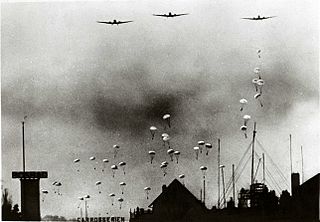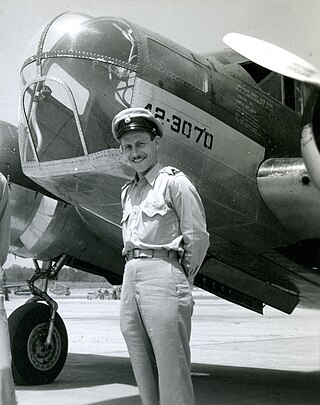
Airborne forces are ground combat units carried by aircraft and airdropped into battle zones, typically by parachute drop. Parachute-qualified infantry and support personnel serving in airborne units are also known as paratroopers.

The Battle of Crete, codenamed Operation Mercury, was a major Axis airborne and amphibious operation during World War II to capture the island of Crete. It began on the morning of 20 May 1941, with multiple German airborne landings on Crete. Greek and other Allied forces, along with Cretan civilians, defended the island. After only one day of fighting, the Germans had suffered heavy casualties and the Allied troops were confident that they would defeat the invasion. The next day, through communication failures, Allied tactical hesitation, and German offensive operations, Maleme Airfield in western Crete fell, enabling the Germans to land reinforcements and overwhelm the defensive positions on the north of the island. Allied forces withdrew to the south coast. More than half were evacuated by the British Royal Navy and the remainder surrendered or joined the Cretan resistance. The defence of Crete evolved into a costly naval engagement; by the end of the campaign the Royal Navy's eastern Mediterranean strength had been reduced to only two battleships and three cruisers.

Despite Dutch neutrality, Nazi Germany invaded the Netherlands on 10 May 1940 as part of Fall Gelb. On 15 May 1940, one day after the bombing of Rotterdam, the Dutch forces surrendered. The Dutch government and the royal family relocated to London. Princess Juliana and her children sought refuge in Ottawa, Canada until after the war.

Kurt Arthur Benno Student was a German general in the Luftwaffe during World War II. An early pioneer of airborne forces, Student was in overall command of developing a paratrooper force to be known as the Fallschirmjäger, and as the most senior member of the Fallschirmjäger, commanded it throughout the war. Student led the first major airborne attack in history, the Battle for The Hague, in May 1940. He also commanded the Fallschirmjäger in its last major airborne operation, the invasion of Crete in May 1941. The operation was a success despite German losses, and led the Allies to hasten the training and development of their own airborne units.
The Netherlands entered World War II on May 10, 1940, when invading German forces quickly overran the country. On December 7, 1941, after the attack on Pearl Harbor, the Netherlands government in exile also declared war on Japan. Operation Market Garden, which started in 1944, liberated the southern and eastern parts of the country, but full liberation did not come until the surrender of Germany on May 5, 1945.

The German invasion of the Netherlands, otherwise known as the Battle of the Netherlands, was a military campaign, part of Case Yellow, the Nazi German invasion of the Low Countries and France during World War II. The battle lasted from 10 May 1940 until the surrender of the main Dutch forces on 14 May. Dutch troops in the province of Zealand continued to resist the Wehrmacht until 17 May, when Germany completed its occupation of the whole country.

Leidschenveen-Ypenburg is a Vinex-location and district of The Hague, located in the southeast. It is geographically connected to the main body of the city by only a narrow corridor. It consists of four quarters: Hoornwijk and Ypenburg on the southwest of the A12 motorway and parallel railway to Utrecht, and Forepark and Leidschenveen on the northeast.

The Battle for The Hague took place on 10 May 1940 during the Battle of the Netherlands. German Fallschirmjäger units were dropped in and around The Hague to capture Dutch airfields and the city itself.

Ypenburg Airport, which later became Ypenburg Air Base was an airport in the Netherlands in Leidschenveen-Ypenburg near the city of The Hague. The ICAO code was EHYB.

The Battle of Fort Ében-Émael was a battle between Belgian and German forces that took place between 10 May and 11 May 1940, and was part of the Battle of Belgium and Fall Gelb, the German invasion of the Low Countries and France. An assault force of German paratroopers, Fallschirmjäger, was tasked with assaulting and capturing Fort Ében-Émael, a Belgian fortress whose strategic position and strong artillery emplacements dominated several important bridges over the Albert Canal. These carried roads which led into the Belgian heartland and were what the German forces intended to use to advance. As some of the German airborne forces assaulted the fortress and disabled the garrison and the artillery pieces inside it, others simultaneously captured three bridges over the canal. Having disabled the fortress, the airborne troops were then ordered to protect the bridges against Belgian counter-attacks until they linked up with ground forces from the German 18th Army.

The Battle of Rotterdam was a Second World War battle fought during the Battle of the Netherlands. Fought between 10 and 14 May 1940, it was a German attempt to seize the Dutch city. It ended in a German victory, following the Rotterdam Blitz.

Valkenburg Naval Air Base is a former air base located just south of Valkenburg, which is part of Katwijk and close to the city of Leiden, that was used by the Netherlands Naval Aviation Service until 2006, being their base for the Lockheed P-3 Orion aircraft. The Orions were sold to the German naval air arm and the Portuguese air force, resulting in the closure of the air base.
Sint-Truiden / Brustem Airfield is an airfield located in Brustem, 1.5 nautical miles southeast of Sint-Truiden (Limburg) and approximately 37 mi (60 km) east of Brussels. Formerly known as Sint-Truiden Air Base or Brustem Air Base, the aerodrome was deactivated as a Belgian Air Component base in 1996.
Goetsenhoven Airfield is a former Belgian Air Component base, located 2 miles (3.2 km) south of Tienen, approximately 26 miles (42 km) east-southeast of Brussels.

Trier Air Base, also known as Trier Euren Airfield, is a former military airfield located in the southwest of Trier, a city in Rhineland-Palatinate, Germany. It was established in 1910. During World War I it was used by the Deutsche Luftstreitkräfte as both a Zeppelin and military airfield. Later, it was used by the Air Service, United States Army, Deutsche Luftwaffe, the United States Army Air Forces, and NATO forces until being closed in 1977, when the airfield was converted into an industrial park.

The Fallschirmjäger were the paratrooper branch of the German Luftwaffe before and during World War II. They were the first paratroopers to be committed in large-scale airborne operations. They were commanded by Kurt Student, the Luftwaffe's second-in-command.

In 1940, Rotterdam was subjected to heavy aerial bombardment by the Luftwaffe during the German invasion of the Netherlands during the Second World War. The objective was to support the German troops fighting in the city, break Dutch resistance and force the Dutch army to surrender. Bombing began at the outset of hostilities on 10 May and culminated with the destruction of the entire historic city centre on 14 May, an event sometimes referred to as the Rotterdam Blitz. According to an official list published in 2022, at least 1,150 people were killed, with 711 deaths in the 14 May bombing alone, and 85,000 more were left homeless.

Lt. Colonel Jhr. Bodo Sandberg was a fighter pilot in the Royal Netherlands Air Force and 'Engelandvaarder' during World War II. He was awarded the Cross of Merit and the Airman's Cross for his bravery during the German invasion of May 1940.

Kijkduin en Ockenburgh is a Dutch subdistrict of the Loosduinen district in The Hague. The subdistrict is located in the western part of The Hague at the municipal border of Monster. The area is bordered by the North Sea, an imaginary line between beach pole 105 and the De Savornin Lohmanlaan, the Machiel Vrijenhoeklaan, the Duinlaan, the Kijkduinsestraat, the Ockenburghstraat, the Loosduinse Hoofdstraat, the Monsterseweg and the municipal border with Monster. The subdistrict consists of two neighborhoods Kijkduin and Ockenburgh.

The Battle of Maleme was one of three main battles that occurred in the Battle of Crete against the Fallschirmjäger, in the Nazi German Mediterranean campaign in 1941. The overall plan was to conquer Crete as part of Operation Merkur, with German Paratroopers landing in three main areas, Heraklion, Maleme and Rethymno. The operation relied on German airborne troops, both paratroopers and in military gliders. Due to a mistake, and despite being in a superior position, New Zealand troops abandoned a strategic hill, leaving it to the Germans, and then lost the airport. The airport was then used by the Germans to transport in more troops which saw the whole island lost to the Germans.


















